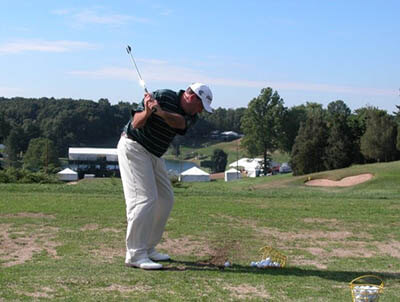Golf Swing Positions: Low Hands, High Clubhead
 A Legacy Post by Keiser University College of Golf Senior Faculty and Director of Research Dr. T. J. Tomasi (1940-2023)
A Legacy Post by Keiser University College of Golf Senior Faculty and Director of Research Dr. T. J. Tomasi (1940-2023)
You don’t have to reach too high to achieve an ideal position at the top of your swing. But most golfers try to swing their hands as high as possible on the backswing because they equate “high hands” with increased power.
Flexible golfers tend to get their hands “up,” and there are players on tour such as Scottie Scheffler and Jon Rahm, who have very high hands. However, I’m convinced that most golfers would benefit greatly from what I call “low hands, high clubhead.”
High Hands Golf Swing
“High” is when you raise your hands above the right ear (for right-handed players), and if this doesn’t fit your body type, there are costs in trying to play with high hands. The danger is that you’ll exceed your flexibility threshold. This threshold varies among individuals, but far more golfers swing beyond their flexibility and balance boundaries than stay within them. It’s crucial to recognize that this approach may not be suitable for every golfer, as it can lead to potential drawbacks and challenges.
Two specific problems are common:
- You straighten your spine angle, rising up from your original address position. This causes your shoulders to turn on a too-flat plane, and if you don’t lower your spine angle perfectly on the downswing, you’ll hit it thin or fat.
- The other problem occurs with the front elbow. In an attempt to get the hands higher, you’re likely to bend your front arm instead of turning your spine for a full coil. So, unless you’re blessed with maximum flexibility or have learned high hands as a junior player, consider playing with low hands.
Low Hands Golf Swing
Low hands are approximately even with the top of the right shoulder, never going above the right ear. The key to developing low hands, high clubhead is maximizing the angle between your front forearm and the clubshaft at the top. The following tips can help create this leverage. First, use a “long” thumb in your grip, extending it fully along the club’s handle. Second, adopt a different pressure point in your grip. At address, exert steady pressure with the pad of your right thumb on the top of your left thumb, somewhat similar to a quarterback taking the snap from center. Third, aim your left arm to 10 o’clock at the top of your backswing.
By incorporating these techniques into their golfing repertoire, players can effectively develop a low hands and high clubhead position, maximizing their swing efficiency and unlocking greater distance and control on the course. With dedicated practice and attention to detail, golfers can refine their technique and elevate their performance to new heights, ultimately enhancing their overall enjoyment and success in the game.

Picture this player standing in the middle of a clock facing you with his head at 12 and his front arm at 10 o’clock.

Low hands, high clubhead with short iron.
Learn more!
Want more tips? If you want to take your game to the next level, contact our team at Keiser University’s College of Golf & Sport Management today. With our dedication and experience, we can elevate your game to new heights together. Give us a call today at 888-355-4465.














